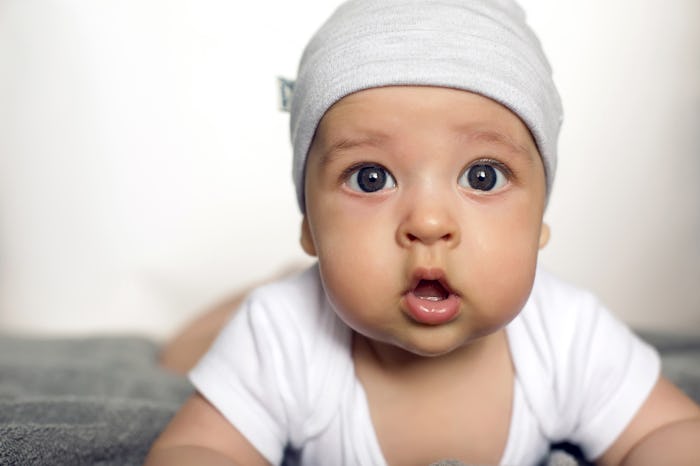Life

They're More Than Just Cute — Here's The Deal With Babies Wearing Hats
When my daughter Claire was born, she had a huge head. I should have known given the size of her parents' heads, but for some reason I ignored this obvious hint and purchased hats fit for a newborn. I even had talented friends knit her sweet little head coverings made from soft, colorful yarn — not a single one fit her. Let's not even talk about the fact that I had a drawer of a hats for a newborn who was born in June. What was I thinking? I mean, do babies have to wear hats all the time? Every cozy newborn photo indicates it's a must, but it didn't make me less curious about the "why" behind it.
Turns out, there's a good reason people are always putting cute hats on baby heads. "Babies need hats more than we do because their heads are proportionately bigger compared to their bodies than ours, resulting in more heat transfer, so a hat prevents too much heating or cooling of the baby," Dr. Charles Shubin, director of pediatrics at Mercy FamilyCare, a division of Family Health Centers of Baltimore, tells Romper.
Sounds like my kid needed two then, huh?
Dr. Eboni Hollier, who is board-certified in both general and developmental and behavioral pediatrics, tells Romper in an email interview that a good rule of thumb for judging whether or not your baby needs a hat is to check the weather ahead of time and notice whether or not you feel chilled when you step outside. "If you feel cold, it is likely that your baby is cold too," she says.
It's not always easy to identify signs that your baby is cold, but experts say a good indicator is that their hands, feet, and/or trunk are cold. They may also be fussy for seemingly no apparent reason. SwaddleDesigns noted that symptoms of a baby that is too cold should not be ignored. Babies cannot shiver like adults and will instead become very quiet and still when they are chilled. When an infant is dangerously cold, they are at risk of neonatal cold syndrome, according to an article in Acta Paediatrica. In addition to symptoms already mentioned, signs of hypothermia in infants include a weak cry, poor feeding, and heart arrhythmias.
Of course, you will also want to be careful of overheating your baby, which can happen at any time of year. If your baby feels feverish but isn't sweating, has a rapid heartbeat, vomits, and/or seems dizzy or confused, then they may be too hot. Baby Center pointed out that, "as a rule of thumb, an infant needs one more layer of clothing than an adult would wear at the same temperature."
As for getting them to keep the damn hat on, that's another story. Moms agree that a chin strap often helps hats stay put, according to Baby Hints and Tips. Others say they were also able to wear their babies down with plain old persistence.
But what about those everyday infant hats like the cap your baby was given at the hospital? Pediatrician Howard Reinstein noted in a Baby Center interview that they aren't necessary once you are home unless the weather calls for extra coverage.
And if you are left with a stockpile of unworn or barely used hats, then take it from me: they are great to donate or pass down to friends with kids whose heads fit through shirt openings. Many of Claire's baby dolls are also sporting a few of my favorites.
Which, naturally, leads us to the age-old question: Does a bigger head mean bigger brains? Experts say the proof isn't exactly solid, but I'd like to think there's a good reason why our family of three has to walk around supporting oversized heads. After all, if not cute hats or genius status, then what?
Check out Romper's new video series, Romper's Doula Diaries:
Check out the entire Romper's Doula Diaries series and other videos on Facebook and the Bustle app across Apple TV, Roku, and Amazon Fire TV.